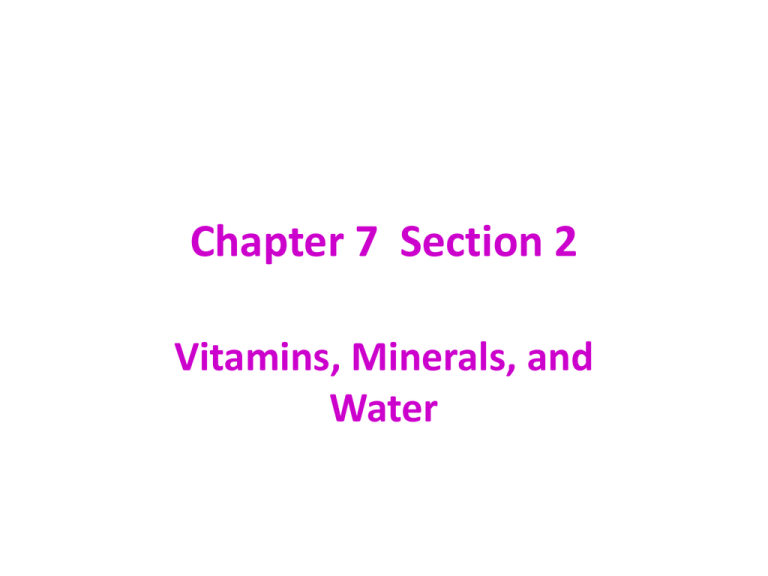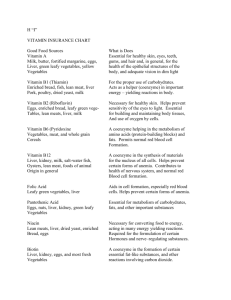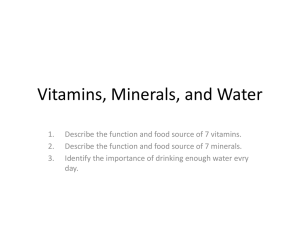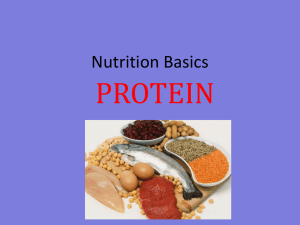
Chapter 7 Section 2
Vitamins, Minerals, and
Water
Bell Ringer
Write the names of the vitamins and
minerals you have heard of and the
kinds of foods in which they can be
found.
Section 2
Vitamins, Minerals, & Water
Key Terms:
Vitamin: A class of nutrients that contain carbon &
are needed in small amounts to maintain health &
allow growth.
Mineral: A class of nutrients that are chemical
elements that are needed for certain body
processes, such as enzyme activity & bone
formation
Nutrient deficiency: The state of not having enough of
a nutrient to maintain good health.
3
Fat-soluble vitamins
Vitamin A, D, E, & K
They dissolve in fat & most can be stored
in fat tissue & remain in the body for a
long time.
4
Fat-Soluble Vitamins
Vitamin A
Milk, yellow &
orange fruits,
eggs, leafy
vegetables
Keeps eyes &
skin healthy
Strong bones &
teeth
Vitamin D
Exposure to
sun
Fish, liver, egg
yolk, fortified
milk
5
Promotes
absorption of
calcium &
phosphorus
Strong bones &
teeth
Vitamin E
Vegetable oils,
beans, peas,
nuts, darkgreen
vegetables,
whole grains
Protects cell
membranes
from damage
by reactive
oxygen (free
radicals)
Vitamin K
Leafy
Acts in blood
vegetables
clotting
such as spinach
& broccoli,
produced in the
intestine by
bacteria
6
Water-soluble Vitamins
• The eight B vitamins and vitamin C
• Needed to release energy from carbohydrates,
fats, & proteins
»
7
Vitamin B-1
(Thiamin)
Most
vegetables,
pork, liver,
beans, whole
grains & cereals,
nuts
Produce energy
from carbs,
helps the
nervous system
function
Vitamin B-2
(Riboflavin)
Milk, meat, eggs,
whole grains,
green leafy veg
pasta
Needed to
produce energy
from carbs,
healthy skin
Vitamin B-3
(Niacin)
Meat, liver, fish,
whole-grains,
peas & beans,
seeds
Needed to
produce energy
from carbs,
nervous system
Vitamin B-5
(Pantothenic
acid)
Whole grains
Meat, liver
Broccoli, eggs,
nuts, peas,
beans
Needed to
produce energy
from
carbohydrates,
fat & protein
Vitamin B-6
(Pyridoxine)
Whole grains,
meat, liver,
fish, bananas,
green leafy
vegetables,
peas & beans
9
Protein
metabolism,
production of
hemoglobin in
red blood cells,
healthy nervous
system
Vitamin B-12
(Cobalamin)
Meat, liver,
Necessary for
dairy
forming cells
products, eggs (including red
blood) & healthy
nervous system
Folate
(Folic acid or
folacin)
Green veg,
liver, whole
grains, peas,
OJ
10
Needed for
forming cells
(including red
blood), helps
prevent birth
defects
Biotin
Liver, yogurt, Necessary for
egg yolk, peas, metabolism
beans, nuts
Vitamin C
(Ascorbic acid)
Citrus fruits,
melons,
strawberries,
green
vegetables,
peppers
11
Promotes
healthy gums &
teeth, healing of
wounds,
absorption of
iron, an
antioxidant to
protect cells
from damage
Minerals
• More than twenty minerals needed in small
amounts to maintain good health
•
12
Calcium
Chromium
Milk, dairy
products,
dark- green,
leafy
vegetables,
tofu, legumes,
shellfish, bony
fish
Meat, dairy
products,
whole grains,
herbs, nuts,
seeds
13
Development &
maintenance of
bones & teeth,
transmission of
nerve impulses,
muscle
coordination,
blood clotting
Helps regulate
blood sugar
Copper
Liver,
shellfish, peas,
beans, nuts,
seeds
Needed for
production of
bone & red blood
cells &
absorption of
iron
Fluoride
Tea, fish,
fluoridated
toothpaste &
water
Helps strengthen
tooth enamel,
helps in
prevention of
cavities
14
Iodine
Iodized salt,
seafood
Needed for
production of
thyroid
hormones &
normal cell
function
Iron
Red meat,
Necessary for
whole &
production of
enriched
hemoglobin
greens, darkgreen
vegetables,
peas, beans, &
eggs
15
Magnesium
Milk, dairy
products,
green, leafy
vegetables,
peas, beans
Needed for bone
growth,
metabolism, &
muscle
contraction
Potassium
Meat, poultry,
fish, bananas,
oranges, dried
fruits,
potatoes,
green, leafy
vegetables,
peas, beans
16
Needed for
maintenance of
fluid balance,
transmission of
nerve impulses &
muscle
contraction
Phosphorus
Cereals, meats, milk, Needed for bone
poultry
formation & cell
reproduction
Selenium
Tuna & other
seafood, whole
grains, liver, meat,
eggs
Needed for healthy
heart function,
antioxidant action,
healthy thyroid
Sodium
Table salt, high-salt
meats (ham),
processed foods,
dairy products, soy
sauce
17
regulation of water
balance in cells &
tissues,
transmission of
nerve impulses
Sulfur
Meat, milk, eggs,
nuts, grains
Needed for protein
metabolism
Zinc
Seafood, meat,
milk, poultry, eggs
Needed for growth &
healing, and for
production of
digestive enzymes
18
Mineral Deficiencies
Calcium
Painful muscle cramps, retarded growth
in children, osteoporosis
Copper
Anemia, bone & cardiovascular changes
Iodine
Enlargement of thyroid gland (goiter),
retardation of growth & brain
development
Anemia, weakness, immune system
impairment
Iron
Magnesium
Nervous system disturbances
19
Sodium
Muscle cramps, loss of appetite
Zinc
Retardation of growth, underdevelopment of sex glands, immune
disorders, slow wound healing
20
How much do we need?
• Sodium: 2,400 milligrams a day (1 ¼ tsp), too
much: high blood pressure: heart disease,
stroke, kidney failure
• Calcium: 1,300 milligrams per day
• (1 cup milk=300 milligrams)
•
21
Water
• 60% of your body is water
• Is necessary for every function of your body.
• Lose water through: excretion of urine &
solid wastes, evaporation through breathing,
& sweating
• Extra water cannot be stored
• Need 8 glasses a day
•
22
Why water is important
• 1. Transports nutrients & oxygen through the
body & helps get rid of wastes
• 2. Provides the proper environment for the
body’s chemical reactions to occur.
• 3. It helps regulate body temperature.
•
23
Why is dehydration dangerous?
• 1. Mild dehydration interferes with mental &
physical performance.
• 2. Early symptoms of dehydration:
• Thirst, headache, fatigue, loss of appetite, dry eyes
& mouth, dark-colored urine
• 3. Severe dehydration:
• Nausea, difficulty concentrating, confusion,
disorientation
• Extremely severe: death
•
24
Review
1. Name the class of nutrient that contain carbon &
are needed in small amounts to maintain health
and allow growth.
(vitamin)
2. Identify the term for “chemical elements that are
needed for enzyme activity & bone formation.”
A. Vitamin B. Protein C. Mineral D. Water
(C)
25
3. Name the term that means “not having enough
of a nutrient to maintain good health.”
(nutrient deficiency)
4. List the functions of Vitamin A, C, and D
(A = Healthy eyes & skin, strong bones & teeth
C= Healthy gums & teeth, promotes healing,
absorption of iron, antioxidant to protect cells
from damage
D=absorption of calcium & phosphorus, strong
bones & teeth
26
5. Name the nutrient that may be related to each of
the following:
A. Iron-deficiency anemia
(iron)
B. Osteoporosis
(calcium)
C. Dehydration
(water)
D. High blood pressure
(sodium)
27
• 6. Identify why the following people are at risk of
dehydration: Sara, who just ran a marathon & Jeff,
who has been vomiting
(Running marathons depletes the body of water
because you don’t have time to drink much water
& vomiting results in water loss as well as reduced
intake)
7. Identify some non-dairy sources of calcium.
(green, leafy vegetables such as spinach & broccoli,
calcium fortified foods such as breads & orange
juice.)
28
8. Give some possible reasons for the decrease in
calcium intake by teens.
(low-fat diets avoiding dairy foods, drinking more
soda and less milk can lower the intake)
29









